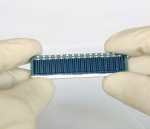A record has been set by the Centre for Solar Energy and Hydrogen Research (ZSW) in Baden-Württemberg, Germany, for thin film solar cell conversion efficiency, which has produced under pilot production conditions.
ZSW said that a 19.6% conversion efficiency had been recorded using an inline multistage process in its automated coating plant and the results have been certified by the Fraunhofer Institute for Solar Energy Systems. The thin film cells are made from from copper-indium-gallium-diselenide (CIS or CIGS for
short)
Manufacturers have produced almost 90 percent of all solar cells from crystalline silicon, such as is seen in polycrystalline solar panels and monocrystalline solar modules, but thin-film technology is becoming more popular. In 2008, thin film solar cells accounted for 12 percent of total installed photovoltaic capacity globally and 20 to 30 percent is forecast for 2010.
One of the current challenges of thin film solar panels are their relative inefficiency compared to other module types; meaning that more thin film panels are required to create the same amount of electricity. This can pose a problem where suitable roof space is limited, such as on the average house. However, ZSW board member Michael Powalla predicts that efficiency levels of between 14 and 15 percent can also be achieved for commercial thin film modules within the next few years.












































